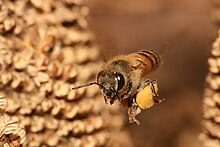Pollen basket

The pollen basket or corbicula (plural corbiculae) is part of the tibia on the hind legs of certain species of bees. They use the structure in harvesting pollen and returning it to the nest or hive. Other species of bee have scopae instead.
Etymology

There was little formal description of the corbicula before Carl Linnaeus explained the biological function of pollen in the mid-18th century. In English the first edition of Encyclopædia Britannica described the structure in 1771 without giving it any special name.[1] The second edition, 1777, refers to the corbicula simply as the "basket".[2] By 1802 William Kirby had introduced the Latin term corbicula into English. He had borrowed it, with acknowledgement, from Réaumur. This New Latin term, like many other Latin anatomical terms, had the advantages of specificity, international acceptability, and culture neutrality.[3] By 1820 the term pollen-basket seems to have gained acceptance in beekeeping vernacular,[4] though a century later a compendium of entomological terminology recognised pollen-plate and corbicula without including "pollen-basket".[5] Yet another century, and authorities as eminent as the current authors of "Imms" included only the terms scopa and corbicula in the index, though they did include "pollen basket" in the text.[6]
The New Latin term corbicula is a diminutive of corbis, a basket or pannier.[7] Corbula (not a term used in entomology) is given as the Late Latin diminutive,[8] but at least one dictionary simply lists corbicula as a very small basket.[9]
Corbicula is the singular; its plural is corbiculae, reflecting the fact that in Latin the gender is feminine,[7] but a troublesome confusion has arisen ever since at least one author c. 1866 assumed corbicula to be the plural of (an actually non-existent neuter form) corbiculum. The error has propagated through successive textbooks[10] and reference works[11] and troublesomely, it still is to be found as a minority misconception in modern publications.[12][13]
Structure and function

Bees in four tribes of the family Apidae, subfamily Apinae: the honey bees, bumblebees, stingless bees, and orchid bees have corbiculae.[14][15] The corbicula is a polished cavity surrounded by a fringe of hairs, into which the bee collects the pollen; most other bees possess a structure called the scopa, which is similar in function, but is a dense mass of branched hairs into which pollen is pressed, with pollen grains held in place in the narrow spaces between the hairs. A honey bee moistens the forelegs with its protruding tongue and brushes the pollen that has collected on its head, body and forward appendages to the hind legs. The pollen is transferred to the pollen comb on the hind legs and then combed, pressed, compacted, and transferred to the corbicula on the outside surface of the tibia of the hind legs.[16]
In Apis species, a single hair functions as a pin that secures the middle of the pollen load. Either Honey or nectar is used to moisten the dry pollen, producing the product known as bee pollen or bee bread. The mixing of the pollen with nectar or honey changes the color of the pollen. The color of the pollen can help identify the pollen source.[17]
References
- ^ Society of Gentlemen in Scotland (1771). Encyclopædia Britannica: Or, A Dictionary of Arts and Sciences, Compiled Upon a New Plan in which the Different Sciences and Arts are Digested Into Distinct Treatises Or Systems; and the Various Technical Terms, Etc., are Explained as They Occur in the Order of the Alphabet. Encyclopædia Britannica. p. 89.
- ^ Bees. J. Balfour and Company W. Gordon. 1778. p. 440.
- ^ William Kirby (1802). Monographia Apum Angliae; Or, An Attempt to Divide Into Their Natural Genera and Families, Such Species of the Linnean Genus Apis as Have Been Discovered in England: with Descriptions and Observations. To which are Prefixed Some Introductory Remarks Upon the Class Hymenoptera, and a Synoptical Table of the Nomenclature of the External Parts of These Insects. With Plates. Vol. 1. [-2.]. By William Kirby . p. 200.
- ^ "The Honeybee". Murray's Magazine. II: 258. 1887. extracted in Bees: Extracts II.
- ^ Smith, John. B. Explanation of terms used in entomology. Pub: Brooklyn Entomological Society 1906. May be downloaded from: [1]
- ^ Richards, O. W.; Davies, R.G. (1977). Imms' General Textbook of Entomology: Volume 1: Structure, Physiology and Development Volume 2: Classification and Biology. Berlin: Springer. ISBN 0-412-61390-5.
- ^ a b Ainsworth, Robert; Eds: Morell, Thomas; Carey, John | An Abridgment of Ainsworth's Latin Dictionary, 13th ed. | London 1834
- ^ Jaeger, Edmund Carroll (1959). A source-book of biological names and terms. Springfield, Ill: Thomas. ISBN 0-398-06179-3.
- ^ William Young (1810). A new Latin-English dictionary: To which is prefixed an English-Latin dictionary. A. Wilson. pp. 22–.
- ^ Alpheus Spring Packard (1868). Guide to the Study of Insects: And a Treatise on Those Injurious and Beneficial to Crops: for the Use of Colleges, Farm-schools, and Agriculturists. Naturalist's agency. p. 116.
- ^ Frederick Augustus Porter Barnard; Arnold Guyot; A.J. Johnson & Co (1890). Johnson's universal cyclopædia: a scientific and popular treasury of useful knowledge. A.J. Johnson.
- ^ George McGavin (1992). Insects of the northern hemisphere. Dragon's World. ISBN 978-1-85028-151-1.
- ^ James L. Castner (2000). Photographic atlas of entomology and guide to insect identification. Feline Press. ISBN 978-0-9625150-4-0.
- ^ George Gordh, Gordon Gordh, David Headrick, A Dictionary of Entomology, Science, 2003; 1040 pages; pg.713
- ^ Bees (Hymenoptera: Apoidea: Apiformes) Encyclopedia of Entomology 2008. Vol. 2, pages 419–434
- ^ Cedric Gillott, Entomology, Springer, 1995; 798 pages; pg. 79
- ^ Dorothy Hodges, The Pollen Loads of the Honeybee, published by Bee Research Association, 1952
